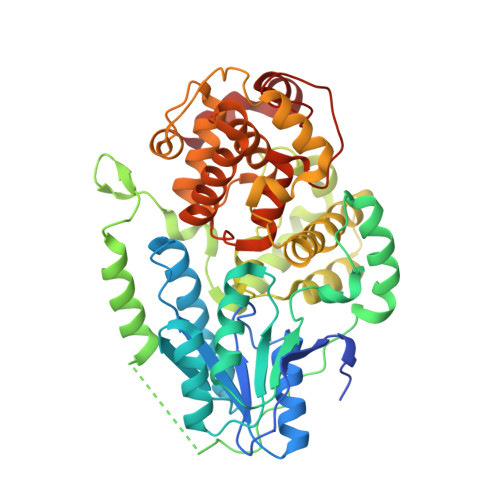Structural and Evolutionary Aspects of Antenna Chromophore Usage by Class II Photolyases.
Kiontke, S., Gnau, P., Haselsberger, R., Batschauer, A., Essen, L.(2014) J Biological Chem 289: 19659
- PubMed: 24849603
- DOI: https://doi.org/10.1074/jbc.M113.542431
- Primary Citation of Related Structures:
4CDM, 4CDN - PubMed Abstract:
Light-harvesting and resonance energy transfer to the catalytic FAD cofactor are key roles for the antenna chromophores of light-driven DNA photolyases, which remove UV-induced DNA lesions. So far, five chemically diverse chromophores have been described for several photolyases and related cryptochromes, but no correlation between phylogeny and used antenna has been found. Despite a common protein topology, structural analysis of the distantly related class II photolyase from the archaeon Methanosarcina mazei (MmCPDII) as well as plantal orthologues indicated several differences in terms of DNA and FAD binding and electron transfer pathways. For MmCPDII we identify 8-hydroxydeazaflavin (8-HDF) as cognate antenna by in vitro and in vivo reconstitution, whereas the higher plant class II photolyase from Arabidopsis thaliana fails to bind any of the known chromophores. According to the 1.9 Å structure of the MmCPDII·8-HDF complex, its antenna binding site differs from other members of the photolyase-cryptochrome superfamily by an antenna loop that changes its conformation by 12 Å upon 8-HDF binding. Additionally, so-called N- and C-motifs contribute as conserved elements to the binding of deprotonated 8-HDF and allow predicting 8-HDF binding for most of the class II photolyases in the whole phylome. The 8-HDF antenna is used throughout the viridiplantae ranging from green microalgae to bryophyta and pteridophyta, i.e. mosses and ferns, but interestingly not in higher plants. Overall, we suggest that 8-hydroxydeazaflavin is a crucial factor for the survival of most higher eukaryotes which depend on class II photolyases to struggle with the genotoxic effects of solar UV exposure.
- From the Biomedical Research Centre/FB15, Unit for Structural Biochemistry, Philipps-University, Hans-Meerwein-Strasse, D-35032 Marburg, Germany.
Organizational Affiliation:




















